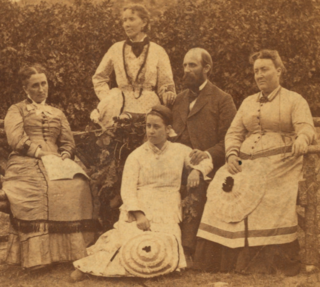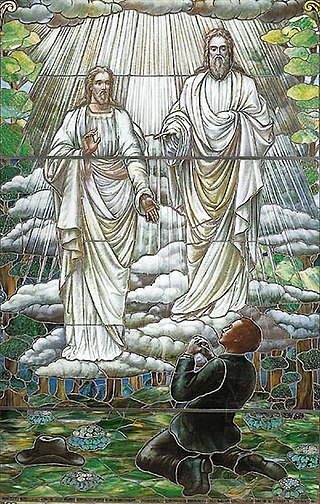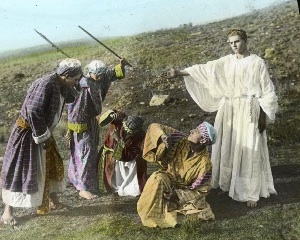The Mormons is a four-hour PBS documentary about the Church of Jesus Christ of Latter-day Saints (LDS Church). The production originally aired in two-hour segments on April 30 and May 1, 2007. It was produced by Helen Whitney, and was the first joint production of Frontline and American Experience .
The first segment is about the history of The Church of Jesus Christ of Latter-day Saints. It recounts the life of Joseph Smith, along with his First Vision and the subsequent visit of the Angel Moroni who gave him the golden plates, from which the Book of Mormon is said to be translated. The topic of anti-Mormonism is also discussed, followed by an episode about Mormonism and polygamy and the Mountain Meadows massacre.
The second segment is about the contemporary LDS Church. It profiles Mormon missionaries, followed by the September Six and a discussion of homosexuality and The Church of Jesus Christ of Latter-day Saints. The final parts cover Mormonism and women and the personal growth experienced by returned missionaries.
The New York Times said about the documentary: "Yet the portrait of the modern-day church, which the program says has 12 million members worldwide, is compelling nonetheless." [1] On the other hand, The Boston Globe criticised the documentary: "The Mormons brims with informed talking heads – church historians, journalists, church elders, and a constellation of happy Mormons. It would have helped to identify Mormon from non-Mormon but never mind. Mitt Romney appears briefly in a film clip but is never heard from; according to PBS, he declined to participate." [2] Reuters however said: "If there is a weak point to this hugely informative and watchable series, it may be the amount of time allocated in the second night to the practice of Mormon missions and the church's heavy-handed approach to critics. Regardless, this is a brilliant work on a engaging topic." [3] The Nation was also disappointed by this documentary. [4]

The Church of Jesus Christ of Latter-day Saints, informally known as the LDS Church or Mormon Church, is the largest Latter Day Saint denomination. Founded by Joseph Smith during the Second Great Awakening, the church is headquartered in Salt Lake City, Utah, and has established congregations and built temples worldwide. According to the church, as of 2023, it has over 17.2 million members of which over 6.8 million live in the U.S. The church also reports over 99,000 volunteer missionaries and 350 temples.

Mormons are a religious and cultural group related to Mormonism, the principal branch of the Latter Day Saint movement started by Joseph Smith in upstate New York during the 1820s. After Smith's death in 1844, the movement split into several groups following different leaders; the majority followed Brigham Young, while smaller groups followed Joseph Smith III, Sidney Rigdon, and James Strang. Most of these smaller groups eventually merged into the Community of Christ, and the term Mormon typically refers to members of the Church of Jesus Christ of Latter-day Saints, as today, this branch is far larger than all the others combined. People who identify as Mormons may also be independently religious, secular, and non-practicing or belong to other denominations. Since 2018, the LDS Church has emphasized a desire for its members be referred to as "members of The Church of Jesus Christ of Latter-day Saints", or more simply as "Latter-day Saints".

The word Mormon most colloquially denotes an adherent, practitioner, follower, or constituent of Mormonism in restorationist Christianity. Mormon also commonly refers, specifically, to a member of the Church of Jesus Christ of Latter-day Saints, which is often colloquially, but imprecisely, referred to as the Mormon Church. In addition, the term Mormon may refer to any of the relatively small sects of Mormon fundamentalism, and any branch of the Latter Day Saint movement that recognizes Brigham Young as the successor to founder Joseph Smith. The term Mormon applies to the religion of Mormonism, as well as its culture, texts, and art.

Mormonism is the theology and religious tradition of the Latter Day Saint movement of Restorationist Christianity started by Joseph Smith in Western New York in the 1820s and 1830s. As a label, Mormonism has been applied to various aspects of the Latter Day Saint movement, although since 2018 there has been a push from The Church of Jesus Christ of Latter-day Saints to distance itself from this label. One historian, Sydney E. Ahlstrom, wrote in 1982 that, depending on the context, the term Mormonism could refer to "a sect, a mystery cult, a new religion, a church, a people, a nation, or an American subculture; indeed, at different times and places it is all of these."

Polygamy was practiced by leaders of the Church of Jesus Christ of Latter-day Saints for more than half of the 19th century, and practiced publicly from 1852 to 1890 by between 20 and 30 percent of Latter-day Saint families.

The First Vision refers to a theophany which Latter Day Saints believe Joseph Smith experienced in the early 1820s, in a wooded area in Manchester, New York, called the Sacred Grove. Smith described it as a vision in which he received instruction from God the Father and Jesus Christ.

The Latter Day Saint movement is the collection of independent church groups that trace their origins to a Christian Restorationist movement founded by Joseph Smith in the late 1820s.
Mormons are people who are members of a religious group that is part of Mormonism and the Latter Day Saint movement.

Mormon cinema usually refers to films with themes relevant to members of the Church of Jesus Christ of Latter-day Saints. The term has also been used to refer to films that do not necessarily reflect Mormon themes but have been made by Mormon filmmakers. Films within the realm of Mormon cinema may be distinguished from institutional films produced by the LDS Church, such as Legacy and Testaments, which are made for instructional or proselyting purposes and are non-commercial. Mormon cinema is produced mainly for the purposes of entertainment and potential financial success.

Polygamy in the Church of Jesus Christ of Latter Day Saints, or plural marriage, is generally believed to have originated with the founder of Mormonism, Joseph Smith. According to several of his associates, Smith taught that polygamy was a divine commandment and practiced it personally, by some accounts marrying more than 30 women, some of whom had existing marriages to other men. Evidence for Smith's polygamy is provided by the church's "sealing" records, affidavits, letters, journals, and diaries. However, until his death, Smith and the leading church quorums denied that he preached or practiced polygamy. Smith's son Joseph Smith III, his widow Emma Smith, and the Reorganized Church of Jesus Christ of Latter Day Saints challenged the evidence and taught that Joseph Smith had opposed polygamy. They instead claimed that Brigham Young, the head of the Church of Jesus Christ of Latter-day Saints, introduced plural marriage after Smith's death. In 1852, leaders of the Utah-based LDS Church publicly announced the doctrine of polygamy.
Various spectrums of beliefs or practice within Mormonism account for categories of Mormons possessing faith or skepticism regarding various doctrines of The Church of Jesus Christ of Latter-day Saints, or pertaining to issues of orthopraxy/heteropraxy, among those identifying as Mormon. People may also partake of Mormon culture to some degree as a result of having been raised in the LDS Church or else having converted and spent a large portion of their life as an active member of the LDS Church. Such "cultural" Mormons may or may not be actively involved with the church. In some cases they may not even be, or have ever been, official members of the church.

John Edward "Ed" Decker is an American counterculture apologist, and evangelist known for his expert studies, books, and public presentations, of the negative aspects of the Church of Jesus Christ of Latter-day Saints and Freemasonry. He is a former member of the LDS Church, and prominent early member of a Christian group for ex-Mormons called Saints Alive in Jesus. His most well-known book is The God Makers: A Shocking Expose of What the Mormon Church Really Believes, co-authored by Dave Hunt.
Latter Day Saints and Mormons have been portrayed in popular media many times. These portrayals often emphasize controversial subjects from the history and beliefs of the Church of Jesus Christ of Latter-day Saints and other branches of the Latter Day Saint movement.
The God Makers is a book and film highlighting the inner workings and perceived negative aspects of the Church of Jesus Christ of Latter-day Saints. Ed Decker and Dave Hunt co-authored the book and film.

Mormonism and Nicene Christianity have a complex theological, historical, and sociological relationship. Mormons express their doctrines using biblical terminology. They have similar views about the nature of Jesus Christ's atonement, bodily resurrection, and Second Coming as mainstream Christians. Nevertheless, most Mormons do not accept the doctrine of the Trinity as codified in the Nicene Creed of 325 and the Nicene-Constantinopolitan Creed of 381. Although Mormons consider the Protestant Bible to be holy scripture, they do not believe in biblical inerrancy. They have also adopted additional scriptures that they believe to have been divinely revealed to Joseph Smith, including the Book of Mormon, the Doctrine and Covenants, and the Pearl of Great Price. Mormons practice baptism and celebrate the sacrament of the Lord's Supper, but they also participate in other religious rituals. Mormons self-identify as Christians.
Islam and Mormonism have been compared to one another since the earliest origins of the latter in the nineteenth century, sometimes by detractors of one or both religions, but also at least once by Joseph Smith, founder of the Latter Day Saint movement, himself. Smith was also frequently referred to as "the Modern Muhammad" by several publications of the era, notably in the New York Herald, shortly after his assassination in June 1844. This epithet repeated a comparison that had been made from Smith's earliest career, one that was not intended at the time to be complimentary.

The Church of Jesus Christ of Latter-day Saints has had a presence in the state of Indiana since 1831. The official church membership as a percentage of general population was 0.68% in 2018. According to the 2014 Pew Forum on Religion & Public Life survey, roughly 1% of Hoosiers self-identify themselves most closely with The Church of Jesus Christ of Latter-day Saints. The LDS Church is the 13th largest denomination in Indiana.
In the Church of Jesus Christ of Latter-day Saints, marriage between a man and a woman is considered to be "ordained of God". Marriage is thought to consist of a covenant between the man, the woman, and God. The church teaches that in addition to civil marriage, which ends at death, a man and woman can enter into a celestial marriage, performed in a temple by priesthood authority, whereby the marriage and parent–child relationships resulting from the marriage will last forever in the afterlife.
This is a bibliography of works on the Latter Day Saint movement.